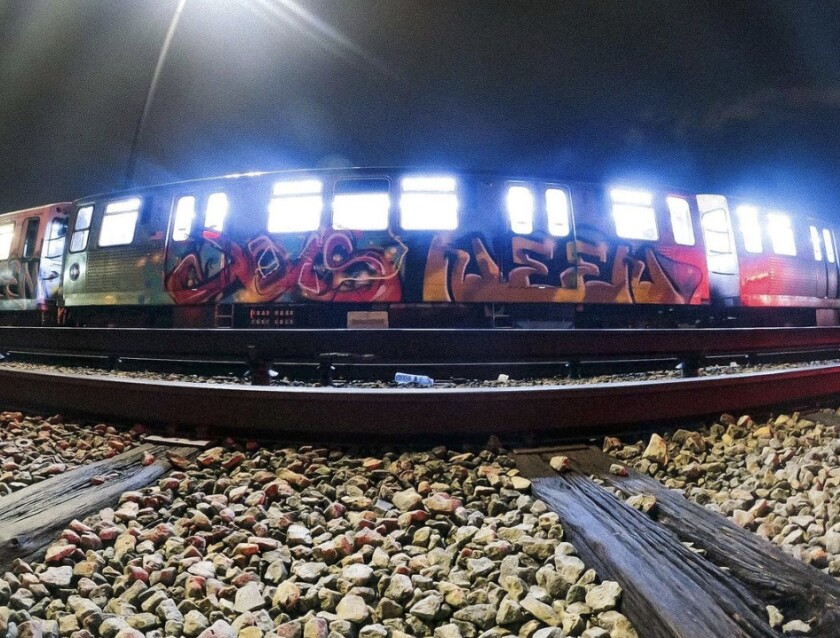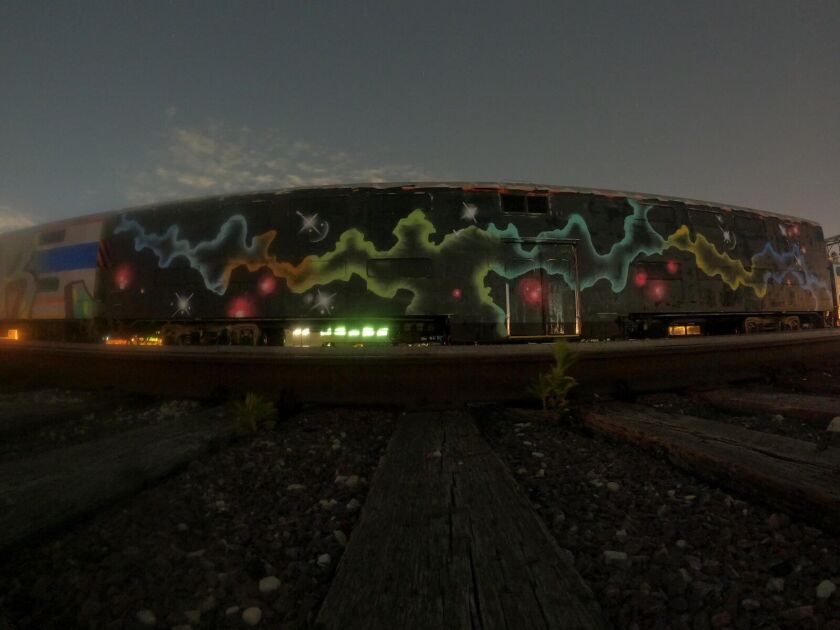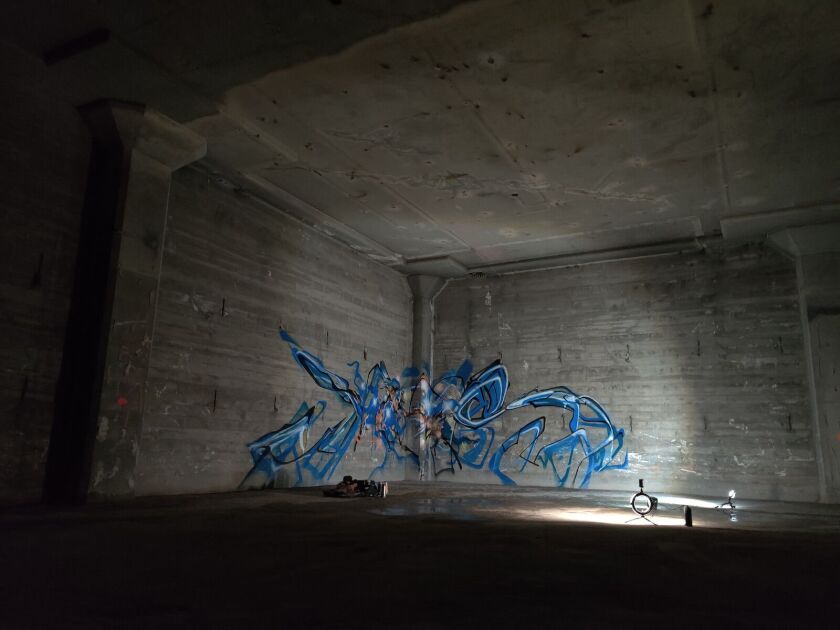Inside a darkened teaching hospital where two stainless-steel autopsy tables, replete with drains, sat side by side.
In the quiet sanctuary of a church.
Inside shuttered schools.
On the concrete foundation of an unfinished home next to a flooded lot he had to wade through.
On towering billboards, dank viaducts, sprawling rooftops.
In a rotting building with floors covered in excrement from the drug users sharing the space.
But it’s L stations and trains that are some of his favorite targets.
“Love trains,” says Joos, a street name pronounced the same as “juice.”
“That’s where the whole thing was born — New York subways,” he says of graffiti art. “And it spilled out from there.”
In just a few years, Joos’ artwork — though he knows some see it not as art but the acts of a vandal — has spilled onto Chicago’s streets to the extent he’s gone from virtual unknown to one of the city’s most prolific and best-known graffiti writers.
Joos has drawn criticism from some quarters for what he does. Pro wrestler Colt Cabana, for instance, took him to task, albeit somewhat tongue-in-cheek, on TikTok in 2021 for tagging a billboard promoting a T-shirt company Cabana markets.
But he’s also won respect from peers and art consumers.
“He’s a beast on the streets,” says Rodney Duran, an artist who owns Happen Space Gallery on the North Side that hosted an art show in February that included Joos’ studio art.
It sold out.
“He’s not, like, a fine artist, but his artwork is considered finer art now,” Duran says. “When you see his work, it’s just so different. He’s doing loose, abstract, messy. But it all comes together.”
One of Joos’ recent and relatively subtle creations is what he calls a “bubble box” — a hazy, snaking marking he spray-paints with a flourish on street-corner utility boxes including some on Milwaukee Avenue, a favored target.
Allan Weinberger of A Very Serious Gallery in River West, which recently sold all 26 of his offerings there, says: “He’s testing the bounds of what graffiti is.”
Joos, who’s in his early 40s and grew up in a Midwestern college town, didn’t enter the graffiti scene till his 30s — late in life for graffiti artists in Chicago, many who’ve been painting or tagging since childhood.
Agreeing to speak with a reporter on the condition that he be identified only by the name he uses for his art and without showing his face, he says he wants to avoid getting arrested for trespassing, defacement or anything else.
“Freedom is important,” he says.
His interest in street artwork was fueled indirectly by a friend’s arrest for something unrelated to graffiti. On probation and wanting to avoid further trouble with the cops, the friend asked Joos to illicitly plaster a bunch of his art, which he’d done on paper, on storefronts around Logan Square.
Joos obliged and says, “I liked the feeling of doing it — a pretty big rush.”
Joos hung out at a Chicago paint store near his home and met a graffiti artist who goes by Nerd who helped teach him and got him hired at the shop.
“I looked up to him,” Joos says. “He’s a very good painter.”
Says Nerd: “He was at the beginning stages of street art. Not really knowing about the real graffiti, dabbling but not into the letter forms. He didn’t have a name yet. He wasn’t ‘Joos’ yet.”
Joos says at first he’d use stencils — cutout designs he’d create and then paint over to make an image.
“They all had to do with well-being and non-religious spirituality,” he says. “They weren’t words. It’d be a guy walking with no face but pills falling out . . . then, there was a profile of a woman’s head with her own head inside and a phone inside of that.”
Likening what he was doing then to the work of a certain well-known but elusive international street artist and activist, Joos says, “I wanted to be like Banksy.”
“But I didn’t really want to be Banksy and push messages on anybody,” he says. “I realized I could just make stuff and not worry about the message.”
Joos describes his philosophy on art this way: “I just like to make things that look awesome. I don’t like to get tied to any specific reasons why I’m doing it. It’s just: The wall needed painting, and I don’t care.”
He took piano lessons growing up, plays multiple instruments and has written music, some for a record label, some for corporate clients that’s played when callers are put on hold. He’s also deejayed relentlessly.
Getting into painting, he says: “I built my own wall so I could practice any time. It was at my neighbor’s house.”
Ironically, Joos is partially color blind, with difficulty distinguishing between reds and greens. “I just go by the names of colors on the cans,” he says.
Joos says his jump to graffiti corresponded with entering recovery.
Painting on the streets, he says, became “a form of harm-reduction: If you’re crushing walls . . . it’s way better for you. I just went crazy, painting constantly, even if it was bad.”
Nerd, who grew up in Uptown, says he started doing graffiti in second grade and sees his friend’s embrace of graffiti as “a healing process.”
Also, he says of Joos: “He likes to travel and jump on his bike. He’s into climbing and high spots and abandoned buildings, not the spots everyone hits.”
It’s the nature of this kind of art that often it won’t stay up for long, getting painted over by rivals or sandblasted or otherwise removed by sanitation workers or building owners. Joos says he’s slipped into a CTA L yard and painted the side of a train, only to have it wiped clean by cleaning crews before anyone else might see it.
He says that’s helped him recognize there are things “beyond my control to change.”
“Doing graffiti is about a tool — to let out frustration, to express yourself, and it helps me let go of things.”
And sometimes his work ends up surviving longer than he expected, like at the Salt Shed, the old Morton Salt building at 1357 N. Elston Ave. Before the iconic building reopened after being transformed into an entertainment venue, Joos painted graffiti on an expanse of wall there and says the venue ended up keeping the painting, which can be seen by Salt Shed patrons.
Much of the time, graffiti writing is about artists getting their names out. Their street names are often what they paint, sometimes in elaborate lettering.
Graffiti can vary by artist and in different cities. Chicago-style graffiti, though, is generally understood to include more readable lettering, albeit often in exaggerated fashion.
“It’s got a lot of swagger to it,” Joos says.
He has several variations of his work, some reflective of that style, some harder to define.
Weinberger says Joos often “confuses the public,” leaving people to wonder if it’s graffiti at all, “or is it a salt stain, is it a water mark?”
Weinberger says of the artist’s more abstract images: “It’s kind of like wildflowers, a burst of color” sprouting “randomly from the cement. It’s very clear he’s got something going on here.”
Nerd says: “I would say his style basically comes from him hitting the streets. When you see it, it’s an expression, it’s a splat. There’s a lot of energy to it.”
Some graffiti artists band together in crews. Joos says he respects that and sometimes paints with friends, including a longtime artist who goes by Neen, but that he isn’t in a crew himself.
He sees himself as more of a loner, saying he’s not a big fan of authority, of being told what to do.
He says he likes to figure things out for himself, like in middle school when his curiosity led him to learn everything he could about computers, even becoming a hacker, helping him later in life when he got into cyber security.
Joos says he liked “trying to break things and test it; I took everything apart as a kid — I got shocked a lot” by electricity.
He says he tries to avoid the deadlier version of such hazards when he’s painting on CTA property near high-voltage L tracks.
None of which the CTA approves of.
“Graffiti is vandalism that is expensive for the CTA to address,” agency spokesman Brian Steele says. “More importantly, CTA’s No. 1 concern is safety. Graffiti is not only a crime, it is also extremely dangerous. When vandals trespass unlawfully into our secure rail yards and other protected areas, they are risking their lives or subjecting themselves to life-altering injuries.”
Joos says he’s not reckless. When assessing spots he might want to mark up, he says, “If I don’t feel it, I leave. If something freaks me out three times, I’m done.”
He says he’s been arrested for graffiti just once.
The sale of spray paint in Chicago has been banned since Mayor Richard M. Daley held office. Joos says he maintains a “wholesale” account to buy it in bulk.
Pointing to a scar above one of his eyes, he says he’s also made his own spray paint and that one time a pressurized can exploded in his hand.
Paint, he says, is like blood flow for him: Both are life-affirming, and both can be messy.
He picked his nickname “kind of randomly,” he says, but his artwork has “a lot of liquid things going on.”

























